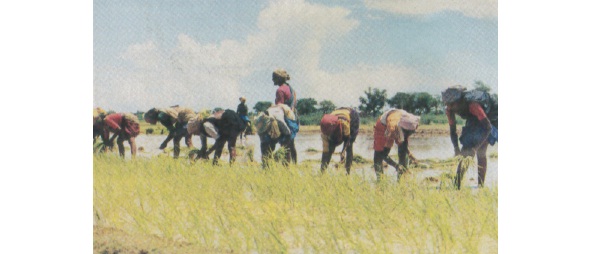by Jim Merk
Gentle eyes and a calm demeanor belie the energy and agenda of Monkombu Sambasivan Swaminathan, better known simply as M.S. Swaminathan or Professor Swaminathan. Yet, this man has not merely touched the lives of millions; he has made those lives possible. He’s a visionary who actually gets things done.
India is one of the world’s most complicated countries. When you step off the plane in New Delhi, you feel not that you have entered a different country, but a different world. It is marvelous and painful at the same moment, an ancient culture wearing a fading British footprint; the birthplace of Buddha, home to 18 official languages and a billion inhabitants. It is not a place where change happens rapidly, unless change is the only solution.
In the early ’60s, India grew some 12 million tons of wheat every year. Starvation was rampant and the country imported much of its food. Swaminathan, an agricultural geneticist, not only developed new strains of high-yield wheat for his country, but also the programs that led to an India which now exports food.
Today, India grows some 70 million tons of wheat. This transformation and its cultural movement were called the “Green Revolution,” and Swaminathan was its leader.
It’s an amazing story, one that demonstrates Swaminathan’s talent for finding solutions amid cultural traditions, governmental bureaucracy, science, the land and its people. It is the story for which he received the World Food Prize in 1987. Fortunately, the story doesn’t end there.
Today the M.S. Swaminathan Research Foundation oversees 13 broad areas of sustainable agriculture and rural development. Like a “tree of development,” its roots are the people, its branches the support for its fruits of success and the blossoms the promise of tomorrow: Swaminathan’s tree.
In addition, Swaminathan was recendy elected as President of the Pugwash Convention. This organization, founded by Albert Einstein and Bertrand Russell—last century’s most important scientist and its leading modern philosopher—was to keep humanity from destroying itself with weapons of mass destruction. Its emphasis continues to be on scientific advances leading to peace. This puts Swaminathan at the forefront of two of the world’s most pressing issues: hunger and war.
Swaminathan has always seen these issues as inextricably linked. He believes the eradication of hunger is the first step towards the eradication of war. The leader of the Green Revolution is now a proponent and leader of the Ever-green Revolution, an expansion of the Green Revolution.
The latter was Commodity Centered—growing more wheat and rice for the future. The Evergreen Revolution is a broader vision that is based on Integrated Natural Resources Management: to enrich and ensure our survival. “An Ever-green Revolution helps to improve productivity in perpetuity without associated ecological or social harm,” says Swarninathan.
In a recent interview with Tokyo Weekender, the professor delivers the outline of his agenda in the way you might expect from a scholar: loaded with detail and with a confident clarity that motivates.
Tokyo Weekender: Tell me about your plans for your Research Foundation.
M.S. Swarninathan: In addition to our ongoing projects, we are developing four broad area—Coastal Area Management, Biodiversity, Ecotechnology/Biovillages and, what we call, “Reaching the Unreached.”
TW: Can you break those down, please?
M.S.: Certainly. India’s northern coastal areas will serve as a model for economic ecology. Today these areas are very poor fishing communities. Fishermen cut down the mangrove trees for fuel and to make money. Slowly these forests are being devastated. So we first need to give the farmers an economic stake for the preservation of the trees.
Mangroves have many benefits beyond burning the wood. They protect the coast from cyclone damage; they consume huge amount of carbon dioxide and help protect smaller plant life important to keep fish stocks fed. From a scientific viewpoint, mangrove trees are interesting for their ability to take their nourishment from saltwater.
We can take these genes and create a rice hybrid that is saline-resistant. This hybrid will become increasingly important as global warming continues and sea levels rise. Huge tracts of rice-growing areas will be inundated and rendered useless unless such a grain is introduced. Of course, there are issues with such genetic engineering, but this allows us to secure our future ability to feed ourselves.
All of these steps create more jobs and, once the fishermen are educated, turn poor communities into areas of economic growth and ecological stability.
TW: This leads us to biodiversity?
M.S.: Yes. Almost everyone knows the importance of biodiversity—keeping the gene pool large. India has many places of megabiodiversity, yet many of these areas are threatened. We have started Community Biodiversity Conservation Programs in which the community becomes the custodian of the program. We are careful to learn as well as teach and die result has been wonderful.
For example, there is a rice called Navara, which for centuries has been used for arthritis. The tribes make Navara-cre, a poultice, which is applied directly to the areas of pain and swelling. Now this is a tradition, so we must validate its effectiveness scientifically, of course.
Another type of rice helps diabetics maintain their sugar levels. It is another area where we blend traditional wisdom with frontier science. Other areas include water conservation, food banks and gene banks.
TW: Water conservation?
M.S.: Yes. In some areas of India, the annual rainfall may take place in only 100 hours. Traditional water storage areas, such as in the temples had been disregarded, but are now coming back for the good of the community.
TW: Interesting. Let’s move to Ecotechnologyand Biovillages.
M.S.: This is a human-centered development: take part in it and reap the rewards. It is pro-nature, pro-poor, pro-woman with an orientation to knowledge empowerment. This is the area under which we set up micro-credit banks, self-help groups, computer training and other education centers. We especially want to target children and women, this is where the “reaching the unreached” program comes in.
TW: OK, let’s talk about this program.
M.S.: We have a whole series of programs for women and children. For example, for women to participate in education or in work outside of the home, we provide total support services from childcare to education. For children we have the “Every Child a Scientist” program. We have Mangrove clubs along the coastal areas that stimulate children’s interest in conservation. Saving the forests without saving the children who live there makes no sense.
TW: How do you manage all of these works?
M.S.: Our people work at the grass-root level and at the policymaking level. For example and in reference to the water conservation techniques I described earlier, with a grass-roots strategy, we have developed an Urban Atlas. This atlas clearly shows the areas of India where poor sanitation or other factors threaten the water supply. These we use at the state and federal government policymaking levels to advance our programs.
TW: You led a session at the Johannesburg Summit 2002. What are your thoughts regarding the conference.
M.S.: Well, I was disappointed. The U.S. President was unable to attend because of the war on terrorism and there seemed to be greater degree of discord rather than cooperation. There is much work to be done.
TW: You are president of the Pugwash convention, appointed at a time of great violence in the world. What will it take to get the world back on the road to peace?
M.S.: We have just prepared event planning and a comprehensive paper that will be taken up at the next conference in Canada 2003. The events and paper being planned will be a manifesto for achieving freedom from the growing nuclear peril by August 2005, the 60th anniversary of the use of atom bombs in Hiroshima and Nagasaki.
The events will, hopefully involve Nobel laureates, business and government leaders who will tackle the nuclear issue, as well as other weapons of mass destruction.
TW: Thank you for your time and good luck in all of your endeavors.
Anyone interested in becoming involved with the activities of the M.S. Swarninathan Research Foundation should contact Friends of MSSRF here in Japan. Please call or e-mail Geeta Mehta at [email protected] or Tel: 03-3443-7550.










